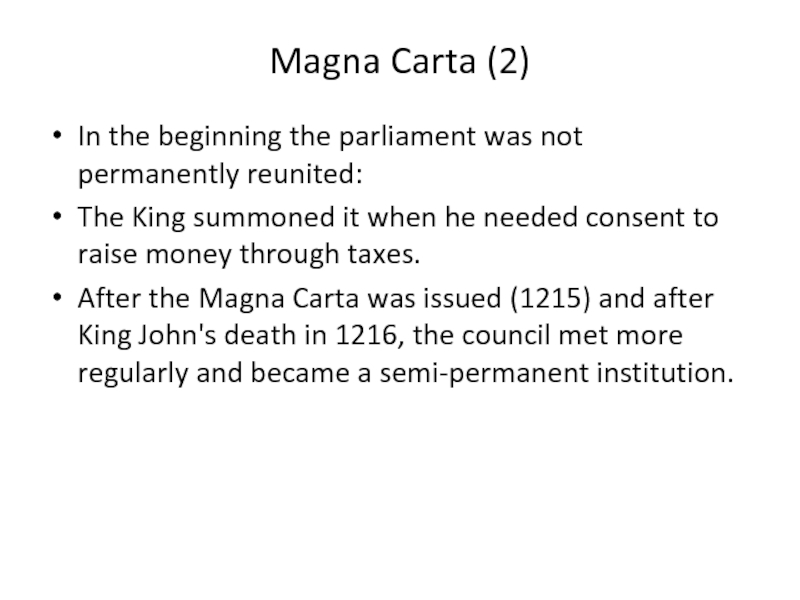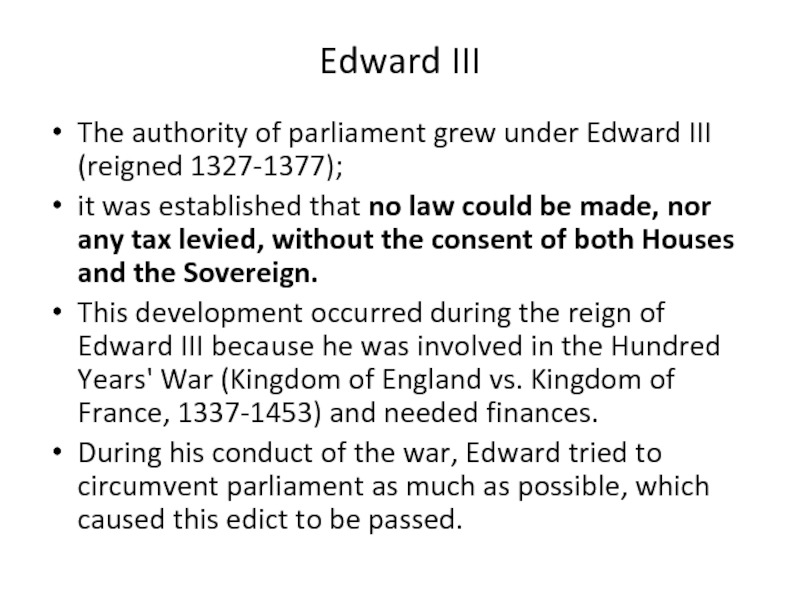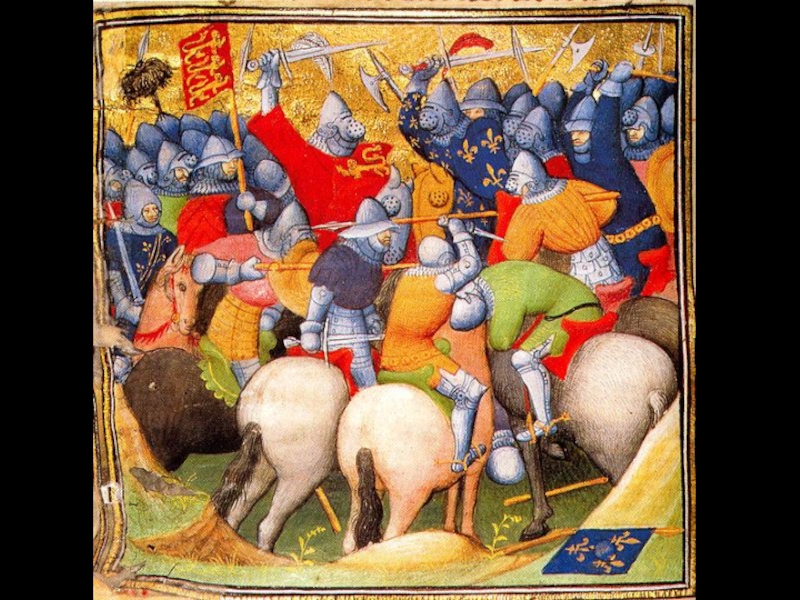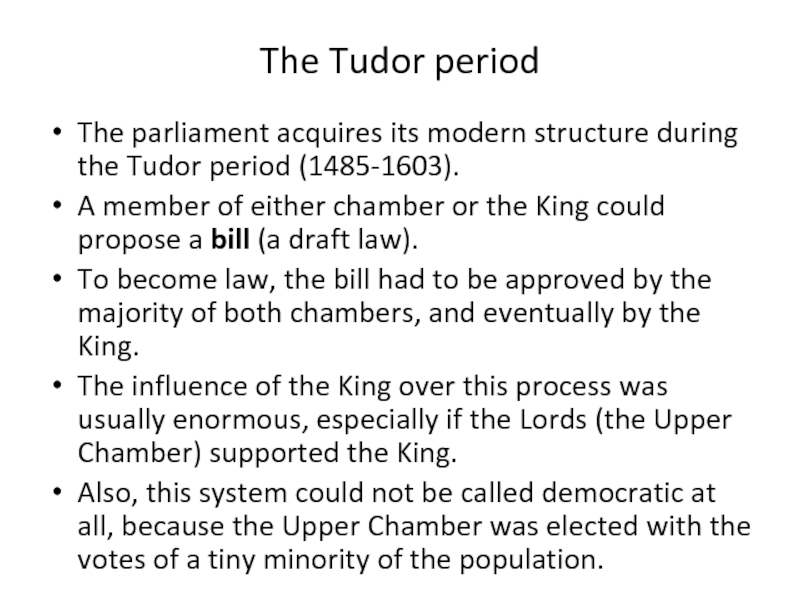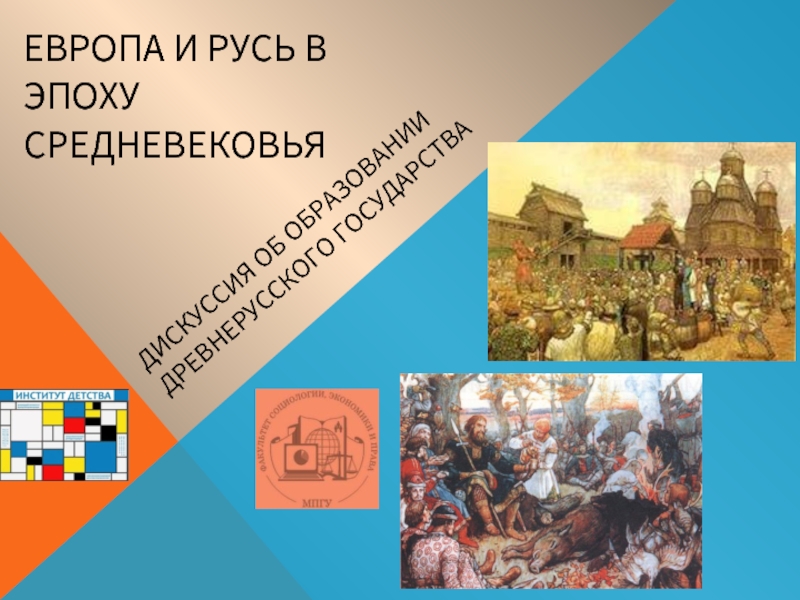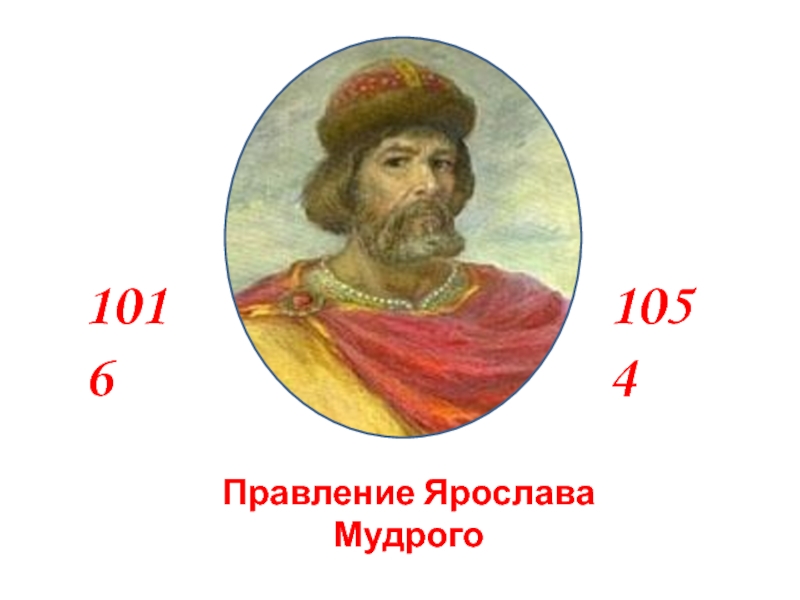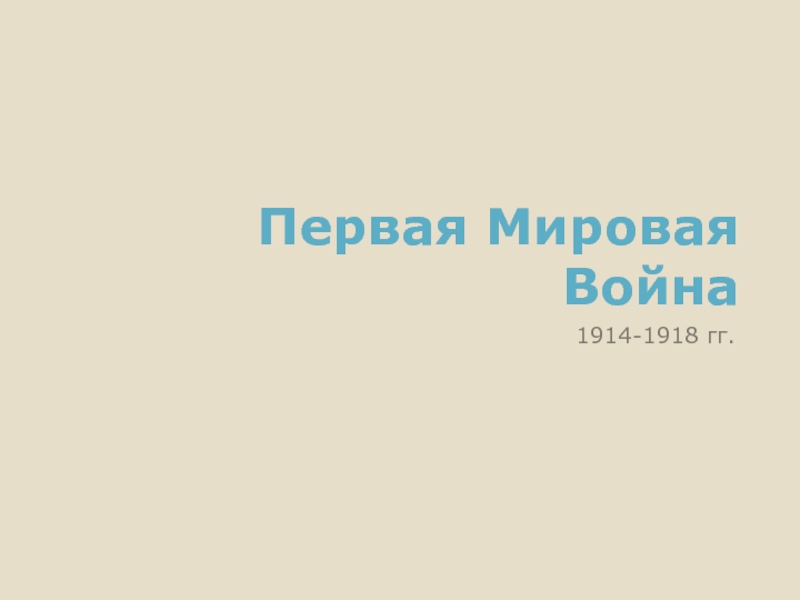- Главная
- Разное
- Дизайн
- Бизнес и предпринимательство
- Аналитика
- Образование
- Развлечения
- Красота и здоровье
- Финансы
- Государство
- Путешествия
- Спорт
- Недвижимость
- Армия
- Графика
- Культурология
- Еда и кулинария
- Лингвистика
- Английский язык
- Астрономия
- Алгебра
- Биология
- География
- Детские презентации
- Информатика
- История
- Литература
- Маркетинг
- Математика
- Медицина
- Менеджмент
- Музыка
- МХК
- Немецкий язык
- ОБЖ
- Обществознание
- Окружающий мир
- Педагогика
- Русский язык
- Технология
- Физика
- Философия
- Химия
- Шаблоны, картинки для презентаций
- Экология
- Экономика
- Юриспруденция
Magna Carta презентация
Содержание
- 1. Magna Carta
- 2. Magna Carta In 1215, the English feudal
- 3. Magna Carta (2) In the beginning the
- 4. Simon de Montfort In the 1260s there
- 5. Simon de Montfort’s legacy These non-noble representatives
- 6. The origins of bicameralism In 1341 the
- 7. Edward III The authority of parliament grew
- 9. The Tudor period The parliament acquires its
- 10. From the Tudors to the Stuarts In
- 12. Charles I In 1628, alarmed by the
- 13. Civil War and Execution of the King
- 15. The Rump Parliament In 1648, the New
- 16. Monarchic restoration The Commonwealth of England -
- 17. The Glorious Revolution James was openly Catholic
- 18. Constitutional monarchy begins The Parliament then offered
- 19. The Bill of Rights The Bill of
- 20. Consequences for British Catholics The Glorious Revolution
- 21. Independent judiciary In 1701, the Act of
- 22. Further developments Following the Treaty of Union
Слайд 2Magna Carta
In 1215, the English feudal barons obtain from King John
I a document called "Magna Carta" (already mentioned in another presentation).
Most important in the Magna Carta was the provision that the King could not collect taxes without the consent of a council of feudal barons and ecclesiastics (church officials).
This royal council later developed into a parliament.
Most important in the Magna Carta was the provision that the King could not collect taxes without the consent of a council of feudal barons and ecclesiastics (church officials).
This royal council later developed into a parliament.
Слайд 3Magna Carta (2)
In the beginning the parliament was not permanently reunited:
The
King summoned it when he needed consent to raise money through taxes.
After the Magna Carta was issued (1215) and after King John's death in 1216, the council met more regularly and became a semi-permanent institution.
After the Magna Carta was issued (1215) and after King John's death in 1216, the council met more regularly and became a semi-permanent institution.
Слайд 4Simon de Montfort
In the 1260s there was a war between the
King and some powerful barons led by Simon de Montfort.
Simon de Montfort captured the King and his son after a battle in 1265, so he considered himself the legitimate ruler of England.
But since many barons were not supporting him anymore, in 1265 Simon de Montfort summoned a parliament and invited to it also non-noble subjects like knights (a man raised by a sovereign to honorable military rank) and burgesses (representatives of a town).
Simon de Montfort obtained that these representatives were elected in the counties and in the urban centers.
Simon de Montfort captured the King and his son after a battle in 1265, so he considered himself the legitimate ruler of England.
But since many barons were not supporting him anymore, in 1265 Simon de Montfort summoned a parliament and invited to it also non-noble subjects like knights (a man raised by a sovereign to honorable military rank) and burgesses (representatives of a town).
Simon de Montfort obtained that these representatives were elected in the counties and in the urban centers.
Слайд 5Simon de Montfort’s legacy
These non-noble representatives were called the Commons (meaning
the representatives of the community of the country).
The King, however, eventually won the civil war and Simon de Montfort died in battle in 1265;
but the fact that the parliament included non-noble elements was established and became a tradition.
The King, however, eventually won the civil war and Simon de Montfort died in battle in 1265;
but the fact that the parliament included non-noble elements was established and became a tradition.
Слайд 6The origins of bicameralism
In 1341 the Commons met separately from the
nobility and clergy for the first time, creating what was effectively an Upper Chamber and a Lower Chamber, with the knights and burgesses sitting in the latter.
This Upper Chamber became known as the House of Lords from 1544 onward, and the Lower Chamber became known as the House of Commons, together called the Houses of Parliament.
This Upper Chamber became known as the House of Lords from 1544 onward, and the Lower Chamber became known as the House of Commons, together called the Houses of Parliament.
Слайд 7Edward III
The authority of parliament grew under Edward III (reigned 1327-1377);
it was established that no law could be made, nor any tax levied, without the consent of both Houses and the Sovereign.
This development occurred during the reign of Edward III because he was involved in the Hundred Years' War (Kingdom of England vs. Kingdom of France, 1337-1453) and needed finances.
During his conduct of the war, Edward tried to circumvent parliament as much as possible, which caused this edict to be passed.
Слайд 9The Tudor period
The parliament acquires its modern structure during the Tudor
period (1485-1603).
A member of either chamber or the King could propose a bill (a draft law).
To become law, the bill had to be approved by the majority of both chambers, and eventually by the King.
The influence of the King over this process was usually enormous, especially if the Lords (the Upper Chamber) supported the King.
Also, this system could not be called democratic at all, because the Upper Chamber was elected with the votes of a tiny minority of the population.
A member of either chamber or the King could propose a bill (a draft law).
To become law, the bill had to be approved by the majority of both chambers, and eventually by the King.
The influence of the King over this process was usually enormous, especially if the Lords (the Upper Chamber) supported the King.
Also, this system could not be called democratic at all, because the Upper Chamber was elected with the votes of a tiny minority of the population.
Слайд 10From the Tudors to the Stuarts
In the mid-1500s the parliament receives
a permanent meeting room in the Palace of Westminster.
The room had been a chapel, so the benches were laid out as a choir, not in a semicircle like in most modern parliaments.
When the last Tudor monarch, Elizabeth I, died in 1603, King James VI of Scotland came to power as King James I, founding the Stuart monarchy.
His son Charles I (1600–49) reigned 1625–49.
The room had been a chapel, so the benches were laid out as a choir, not in a semicircle like in most modern parliaments.
When the last Tudor monarch, Elizabeth I, died in 1603, King James VI of Scotland came to power as King James I, founding the Stuart monarchy.
His son Charles I (1600–49) reigned 1625–49.
Слайд 12Charles I
In 1628, alarmed by the arbitrary exercise of royal power,
the House of Commons submitted to Charles I the Petition of Right, demanding the restoration of their liberties.
Though he accepted the petition, Charles later dissolved parliament and ruled without them for eleven years.
It was only after the financial disaster of the Scottish Bishops' Wars (1639–1640) that he was forced to recall Parliament so that they could authorize new taxes.
This resulted in the calling of the assemblies known historically as the Short Parliament of 1640 and the Long Parliament, which sat with several breaks and in various forms between 1640 and 1660.
Though he accepted the petition, Charles later dissolved parliament and ruled without them for eleven years.
It was only after the financial disaster of the Scottish Bishops' Wars (1639–1640) that he was forced to recall Parliament so that they could authorize new taxes.
This resulted in the calling of the assemblies known historically as the Short Parliament of 1640 and the Long Parliament, which sat with several breaks and in various forms between 1640 and 1660.
Слайд 13Civil War and Execution of the King
The final victory of the
parliamentary forces was a turning point in the history of the Parliament of England.
This marked the point when parliament replaced the monarchy as the supreme source of power in England.
Battles between Crown and Parliament would continue throughout the 17th and 18th centuries, but parliament was no longer subservient to the English monarchy.
This change was symbolized in the execution of Charles I in January 1649.
This marked the point when parliament replaced the monarchy as the supreme source of power in England.
Battles between Crown and Parliament would continue throughout the 17th and 18th centuries, but parliament was no longer subservient to the English monarchy.
This change was symbolized in the execution of Charles I in January 1649.
Слайд 15The Rump Parliament
In 1648, the New Model Army (which by then
had emerged as the leading force in the parliamentary alliance) purged Parliament of members that did not support them.
The remaining "Rump Parliament", as it was later referred to by critics, enacted legislation to put the king on trial for treason.
This trial, the outcome of which was a foregone conclusion, led to the execution of the king and the start of an 11 year republic.
The House of Lords was abolished and the purged House of Commons is summoned and dismissed various times.
The remaining "Rump Parliament", as it was later referred to by critics, enacted legislation to put the king on trial for treason.
This trial, the outcome of which was a foregone conclusion, led to the execution of the king and the start of an 11 year republic.
The House of Lords was abolished and the purged House of Commons is summoned and dismissed various times.
Слайд 16Monarchic restoration
The Commonwealth of England - the republican government of England
- lasts until 1660.
After internal conflicts within the government and the army, the monarchy is restored with the King Charles II, son of Charles I.
Charles II died in 1685 and he was succeeded by his brother James II.
During his lifetime Charles had always pledged loyalty to the Protestant Church of England, despite his private Catholic sympathies.
After internal conflicts within the government and the army, the monarchy is restored with the King Charles II, son of Charles I.
Charles II died in 1685 and he was succeeded by his brother James II.
During his lifetime Charles had always pledged loyalty to the Protestant Church of England, despite his private Catholic sympathies.
Слайд 17The Glorious Revolution
James was openly Catholic and pro-France.
James also attempted to
lift restrictions on Catholics taking up public offices.
This was bitterly opposed by Protestants in his kingdom.
They invited William of Orange, a Protestant who had married Mary, daughter of James II and Anne Hyde to invade England and claim the throne.
This is known as the Glorious Revolution (1688).
This was bitterly opposed by Protestants in his kingdom.
They invited William of Orange, a Protestant who had married Mary, daughter of James II and Anne Hyde to invade England and claim the throne.
This is known as the Glorious Revolution (1688).
Слайд 18Constitutional monarchy begins
The Parliament then offered the Crown to his Protestant
daughter Mary, instead of his son (James Francis Edward Stuart).
Mary refused the offer, and instead William and Mary ruled jointly.
As part of the compromise in allowing William to be King, the Parliament was able to have the 1689 Bill of Rights and later the 1701 Act of Settlement approved.
These were statutes that lawfully upheld the prominence of parliament for the first time in English history.
These events marked the beginning of the English constitutional monarchy and its role as one of the three elements of parliament.
Mary refused the offer, and instead William and Mary ruled jointly.
As part of the compromise in allowing William to be King, the Parliament was able to have the 1689 Bill of Rights and later the 1701 Act of Settlement approved.
These were statutes that lawfully upheld the prominence of parliament for the first time in English history.
These events marked the beginning of the English constitutional monarchy and its role as one of the three elements of parliament.
Слайд 19The Bill of Rights
The Bill of Rights of 1689 joined the
Magna Carta of 1215 as foundations of English constitutionalism.
The Bill mandated:
parliamentary consent for a peacetime standing army
free election of Parliament
parliamentary approval of the suspension of law or levying of taxes
regular parliamentary sessions
limitations on bail, fines, and cruel and unusual punishment.
The Bill mandated:
parliamentary consent for a peacetime standing army
free election of Parliament
parliamentary approval of the suspension of law or levying of taxes
regular parliamentary sessions
limitations on bail, fines, and cruel and unusual punishment.
Слайд 20Consequences for British Catholics
The Glorious Revolution (1688) permanently ended any chance
of Catholicism becoming re-established in England.
For Catholics its effects were disastrous:
Catholics were denied the right to vote and sit in the Westminster Parliament for over a century;
they were denied commissions in the army
the monarch was forbidden to be Catholic or to marry a Catholic (a prohibition still in force).
For Catholics its effects were disastrous:
Catholics were denied the right to vote and sit in the Westminster Parliament for over a century;
they were denied commissions in the army
the monarch was forbidden to be Catholic or to marry a Catholic (a prohibition still in force).
Слайд 21Independent judiciary
In 1701, the Act of Settlement created an independent judiciary,
with judges removable only by the Parliament.
The Act confirmed what Edward Coke had said decades earlier, the sovereign may not dismiss judges.
The Act confirmed what Edward Coke had said decades earlier, the sovereign may not dismiss judges.
Слайд 22Further developments
Following the Treaty of Union in 1707, Acts of Parliament
passed in the Parliament of England and the Parliament of Scotland created a new Kingdom of Great Britain and dissolved both parliaments, replacing them with a new Parliament of Great Britain based in the former home of the English parliament.
The Parliament of Great Britain later became the Parliament of the United Kingdom in 1801 when the United Kingdom of Great Britain and Ireland was formed through the Act of Union 1800.
The Parliament of Great Britain later became the Parliament of the United Kingdom in 1801 when the United Kingdom of Great Britain and Ireland was formed through the Act of Union 1800.


